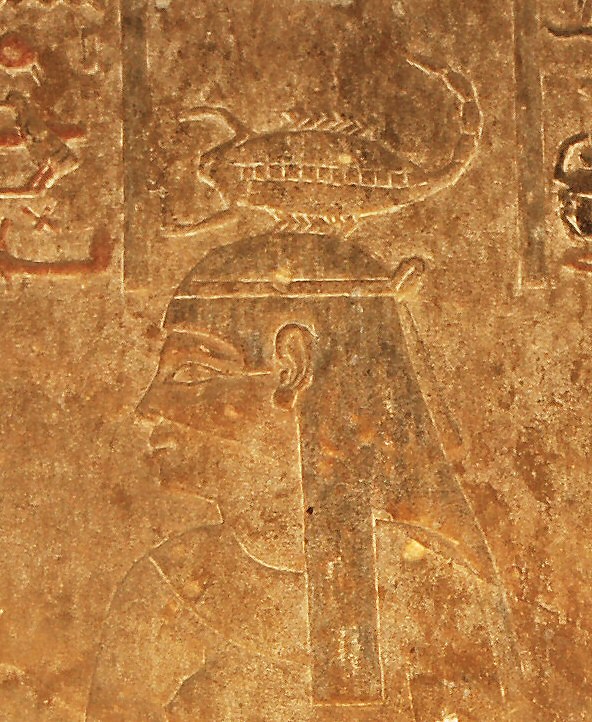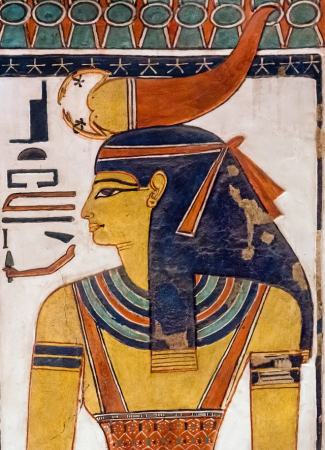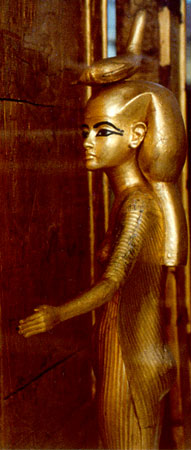
Serqet (Serket, Selket,Selqet, Selkit, Selkis) was a ancient Egyptian scorpion goddess. She was generally viewed as a protective goddess, but also had a darker side.
Serqet was thought to have power over venomous snakes and scorpions, like Meretseger and Isis. It was believed that she could protect a person from venomous bites, and also that she could send snakes and scorpions to mete out punishment to those of whom she disapproved.

She was originally worshiped in the Delta, but her popularity spread throughout the land and cult centres were established at Djeba (Edfu), and Per-Serqet (Pselkis, el Dakka). However, no temples specifically dedicated to her has been recovered.
According to some versions of the story, it is Serqet who helps protect Isis and her infant son Horus when they are hiding from Set in the marshes of the delta. She is associated with the seven scorpions who act as a body guard for the mother and child and is sometimes named as the goddess who convinces Ra to stop the sun barque and help when Horus is poisoned by a magical snake sent by Set. Because of this story, she was thought to offer special protection to children and pregnant women from venomous animals.
Serqet also protected Ra as he travelled though the underworld each night. She was said to watch over any dangerous twist in the path and was responsible for restraining the serpent Apep when he was imprisoned in the netherworld and protecting the sun god’s barqe from his attack. This protection was extended to everyone who made the difficult journey through the netherworld.

In the tomb of Nefertari (above), the site o0f Rameses II, the goddess welcomes the queen into the afterlife saying “(I am) Serqet, mistress of heaven and lady of all the gods. I have come before you, the King’s Great Wife, Mistress of the Two Lands, Lady of Upper and Lower Egypt, Nefertari, Beloved of Mut, Justified Before Osiris Who Resides in Abydos, and I have accorded you a place in the sacred land, so that you may appear gloriously in heaven like Ra.”

However, like the other goddesses known as the “Eye of Ra”, she was thought to be either the mother or daughter of Ra, who was embodied in the scorching heat of the sun.
She was given the epithet, “Lady of the Beautiful Tent” and “Mistress of the Beautiful House”, (referring to the embalmer’s tent). She also protected Qebehsenuef (one of the four sons of Horus) who guarded the intestines of the deceased.
She was associated with the western cardinal point (the west was associated with death and rebirth). Yet, she was also closely associated with the breath of life. Her enemies would have their breath literally taken away by the effect of a poisonous bite, but she also gave the justified dead the breath of life in the afterworld. In the Book of the Dead, she is associated with the teeth of the deceased. A longer version of her name (srq.t-Ht.w) is often translated as “She Who Lets Throats Breathe”, or conversely “she who stiffens (paralyses) the throat”.
According to the Pyramid Texts she was the mother of Nehebkau, the snake god who protected the pharaoh from snakebites. She was closely associated with Isis and her sister Nephthys because of her connection with magic and the underworld. In Edfu she was said to be the wife of Horus and the mother of Horakhty (Horus of the Horizon).
Serqet often appeared with the ancient warrior goddess Neith. In the mortuary temple of Hatshepsut Neith and Serqet are present when Amun impregnates Hatshepsut’s mother, Mutemwia. In another tale the two goddesses ensure that Amun and his wife get to enjoy some quality time in peace, and so she was also considered to be a goddess of marriage.

Serqet was often shown as a woman with a scorpion on her head, and occasionally as a scorpion with the head of a woman, though this was rare. She was sometimes shown wearing the headdress of Hathor (a solar disk and cow horns) but it is thought that this was more to do with her association with Isis.
From the Twenty-First Dynasty, she was occasionally depicted with the head of a lioness and a protective crocodile at the back of her neck. However, the most famous image of Serqet is the golden figure that forms one of the four goddesses protecting Tutankhamun which was found in his tomb.
Bibliography
- Bard, Kathryn (2008) An introduction to the Archaeology of Ancient Egypt
- Pinch, Geraldine (2002) Handbook Egyptian Mythology
- Redford Donald B (2002) Ancient Gods Speak
- Watterson, Barbara (1996) Gods of Ancient Egypt
- Wilkinson, Richard H. (2003) The Complete Gods and Goddesses of Ancient Egypt
Copyright J Hill 2009